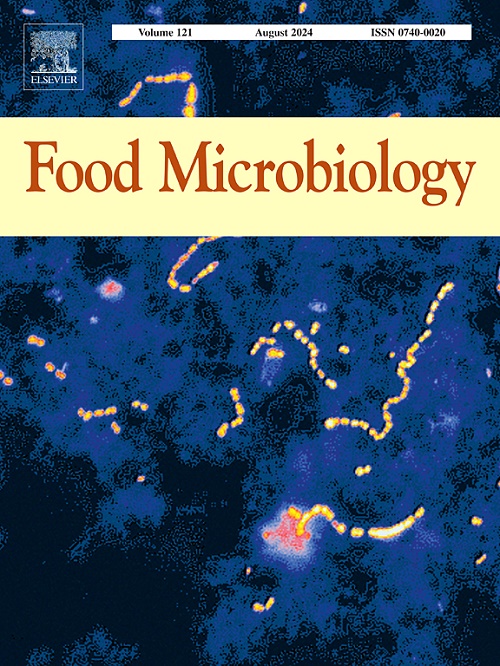Microbial composition and dynamics in environmental samples from a ready-to-eat food production facility with a long-term colonization of Listeria monocytogenes
IF 4.5
1区 农林科学
Q1 BIOTECHNOLOGY & APPLIED MICROBIOLOGY
引用次数: 0
Abstract
Listeria monocytogenes is a foodborne pathogen of significant concern for the food industry due to its remarkable ability to persist through safety control efforts, posing a subsequent health threat to consumers. Understanding the microbial communities coexisting with L. monocytogenes in food processing environments provides insights into its persistence mechanisms. We investigated the microbial communities on non-food contact surfaces in a facility producing ready-to-eat foods, known to harbour a ST121 L. monocytogenes strain over multiple years. A 10-week sampling period was coordinated with the company and public health authorities. Metagenomic analysis revealed a stable microbial composition dominated by Pseudomonas fluorescens. While highly related populations were present in high-care production zones, distinctive taxa characteristic of specific areas were observed (e.g., Sphingomonas aerolata). Although Listeria spp. were not detected in metagenomes, they were detected in cultured samples, suggesting low relative abundance in factory settings. The findings suggest that a stable resident microbiota, with distinct adaptations to different areas within the factory, was selected for by their collective ability to survive control efforts in this environment. Listeria spp. was a member of this microbial community, albeit at low abundance, and may likewise benefit from the mutualism of the overall microbial community.
李斯特菌长期定植的即食食品生产设施环境样本中的微生物组成和动态变化
单核细胞增生李斯特菌是一种食源性致病菌,由于其在安全控制工作中的顽强生命力,食品工业对其极为关注,并因此对消费者的健康构成威胁。了解食品加工环境中与单增李斯特菌共存的微生物群落有助于深入了解其持久性机制。我们调查了一家生产即食食品的工厂内非食品接触表面的微生物群落,已知该工厂多年来一直存在 ST121 型单核细胞增生奈氏菌菌株。在公司和公共卫生机构的协调下,进行了为期 10 周的采样。元基因组分析显示,微生物组成稳定,以荧光假单胞菌为主。虽然高护理生产区存在高度相关的种群,但也观察到了特定区域特有的分类群(如气溶胶鞘氨单胞菌)。虽然在元基因组中没有检测到李斯特菌属,但在培养样本中却检测到了它们,这表明它们在工厂环境中的相对丰度较低。研究结果表明,稳定的常驻微生物群对工厂内的不同区域具有不同的适应性,它们能够在这种环境下的控制工作中存活下来。李斯特菌属是这一微生物群落的成员,尽管丰度较低,但可能同样受益于整个微生物群落的互利性。
本文章由计算机程序翻译,如有差异,请以英文原文为准。
求助全文
约1分钟内获得全文
求助全文
来源期刊

Food microbiology
工程技术-生物工程与应用微生物
CiteScore
11.30
自引率
3.80%
发文量
179
审稿时长
44 days
期刊介绍:
Food Microbiology publishes original research articles, short communications, review papers, letters, news items and book reviews dealing with all aspects of the microbiology of foods. The editors aim to publish manuscripts of the highest quality which are both relevant and applicable to the broad field covered by the journal. Studies must be novel, have a clear connection to food microbiology, and be of general interest to the international community of food microbiologists. The editors make every effort to ensure rapid and fair reviews, resulting in timely publication of accepted manuscripts.
 求助内容:
求助内容: 应助结果提醒方式:
应助结果提醒方式:


